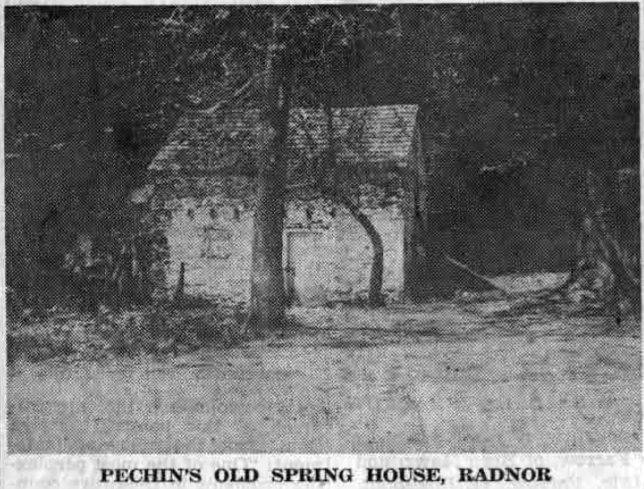 The quaint old postcard picture from which the illustration shown above was reproduced, was made well over 50 years ago. And as often happens, the way by which the postcard reached this column is almost as interesting as the story of the picture itself.
The quaint old postcard picture from which the illustration shown above was reproduced, was made well over 50 years ago. And as often happens, the way by which the postcard reached this column is almost as interesting as the story of the picture itself.
On a recent visit to Wayne, Mrs. Elizabeth Frame Woodlow, a resident of Brookline, presented the old picture to Miss Mary Brooke, of St. Davids avenue. A number of years ago the two were neighbors in Radnor. Miss Brooke’s parents, the late Mr. and Mrs. Horace L. Brooke lived on King of Prussia road, on what is now the Charles M. Tatum place. The Frame family, of which Mrs. Woodlow is a member, lived near the corner of Weadley and King of Prussia roads.
Mrs. Woodlow, who moved away from Radnor township more than 30 years ago, has given the picture to Miss Brooke because it shows the original spring house on the Pechins’ farm. The Pechins are old-time settlers of Radnor township, to whom Miss Brooke is closely related. Miss Brooke, in turn, has lent the postcard for use in “Your Town and My Town.”
In her story accompanying the picture, Miss Brooke has given the following interesting facts:
“The small stone springhouse was built more than 100 years ago. It stood on the site now occupied by the gate house of ‘Villa Cabrini’ on King of Prussia road, north of Eagle road, and was torn down when James W. Paul built the present gatehouse, about 60 years ago.
“Few residents of the township will remember it, still less that it was used by the parents of Peter Pechin, Edward and Ann Wagner Pechin, who lived in the homestead on the opposite side of King of Prussia road (now owned by William Gerhard).
“Subsequently, the homestead was sold to Mr. Watson and Peter Pechin and his family moved to the farm east of Eagle road, and the springhouse was little used, except by an old Civil War veteran, named Jim Donaldson, who was a sort of handy-man on the Pechin farm. Jim used to sing old Civil War songs, such as ‘Carry me Back to Old Virginny,’ ‘Old Uncle Ned’ to the grandchildren.
“Occasionally, Jim would go on a binge – his favorite beverage, when he couldn’t get the real thing, was paregoric, and he slept off the effects in the room over the spring, the entrance to which was at the right end of the building.
“About once or twice a year, a band of gypsies camped in the field adjoining the springhouse, at the corner of Eagle and King of Prussia roads. They were English gypsies, the Stanley and Wells families, who owned beautifully decorated wagons and fine horses. Once, when they were camping in Radnor, one of their horses became tangled in barbed wire and was badly cut. They sent one of their men to borrow a Bible from Mr. Pechin. He asked what they wanted with it and he was told that there was a verse in the Old Testament which, when repeated, would stop the flow of blood. He asked them to tell him where to find it, but the reply was that a man couldn’t tell another man, or the charm wouldn’t work, but they would leave a straw in the place where the verse was found and since it referred to blood, he would be able to identify it. Of course, the bleeding of the horse was stopped!
“It is evident that the trouble the State Highway Department has been having with an overflowing spring at this location, on King of Prussia road, is caused by the self-same spring over which the old springhouse was erected.”
